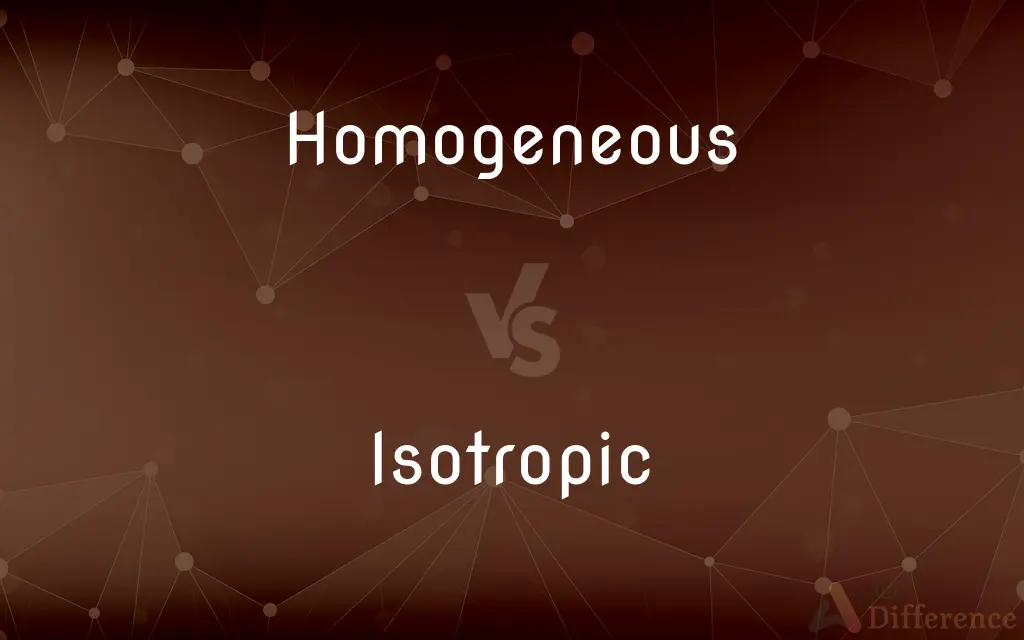Homogeneous vs. Isotropic — What's the Difference?
By Maham Liaqat & Urooj Arif — Updated on April 18, 2024
Homogeneous materials have uniform composition and properties throughout, while isotropic materials exhibit the same properties in all directions.

Difference Between Homogeneous and Isotropic
Table of Contents
ADVERTISEMENT
Key Differences
Homogeneous refers to a material or mixture that has a uniform composition throughout its entire mass. It means that any sample taken from the material will have the same properties as any other sample, regardless of size or location. On the other hand, isotropic materials have identical properties in all directions, meaning their physical properties are the same no matter how you measure them, whether in terms of strength, thermal conductivity, or refractive index.
While all isotropic materials are homogeneous, as their uniform properties in every direction imply a uniform composition, not all homogeneous materials are isotropic. For example, wood is homogeneous if the grain is consistent throughout, but it is anisotropic because its properties vary with the direction relative to the grain.
In practical applications, engineers and designers must consider whether a material's homogeneous nature aligns with its isotropic properties depending on the requirements of the project. For instance, in constructing a building, materials that are both homogeneous and isotropic, like poured concrete, are often preferred for their predictability and uniform strength.
Scientifically, the study of homogeneous materials focuses on their composition and uniformity, while isotropic materials are studied for their directional independence. This distinction is crucial in fields such as materials science, physics, and engineering, where understanding these properties can significantly impact the selection of materials for specific applications.
Understanding whether a material is homogeneous or isotropic is crucial for applications involving wave propagation, like sound or light. Homogeneity ensures that the wave travels uniformly, whereas isotropy ensures that the wave behaves the same in every direction, which is particularly important in optics and acoustics.
ADVERTISEMENT
Comparison Chart
Definition
Uniform composition throughout
Same properties in every direction
Key Properties
Uniformity, consistency
Directional independence
Example Materials
Stainless steel, glass
Air, pure metals
Importance in Science
Studied for composition uniformity
Studied for directional properties
Typical Applications
Chemical solutions, alloys
Optics, acoustics
Compare with Definitions
Homogeneous
Uniform in composition throughout its structure.
Glass is homogeneous as it exhibits the same properties throughout.
Isotropic
Exhibits identical physical properties in all directions.
The isotropic nature of air makes it ideal for studying sound propagation.
Homogeneous
Consistently mixed, showing no variation in characteristics.
Stainless steel is used in kitchenware for its homogeneous nature.
Isotropic
Often used in reference to materials in optics and acoustics.
Optical fibers need to be isotropic to efficiently transmit light.
Homogeneous
Important in material science for creating substances with consistent qualities.
Homogeneous alloys are crucial in aerospace applications.
Isotropic
Essential for applications requiring uniform performance regardless of orientation.
Isotropic rubber gaskets provide reliable seals.
Homogeneous
Can appear layered yet still remain homogeneous if each layer has uniform properties.
Stratified rock layers can be homogeneous within each layer.
Isotropic
Critical in the design of devices that rely on uniform thermal expansion.
Isotropic materials are selected for parts that undergo heating.
Homogeneous
Often necessary for chemical reactions to proceed efficiently.
Homogeneous mixtures ensure uniform reaction conditions.
Isotropic
Desirable in many manufacturing processes to avoid directional weakness.
Isotropic metals are preferred in high-stress engineering applications.
Homogeneous
Of the same kind; alike
If all jobs and workers were homogeneous
Isotropic
Identical in all directions; invariant with respect to direction.
Homogeneous
Denoting a process involving substances in the same phase (solid, liquid, or gaseous)
Homogeneous catalysis
Isotropic
(physics) Having properties that are identical in all directions; exhibiting isotropy
Homogeneous
Consisting of parts that are the same; uniform in structure or composition
"a tight-knit, homogeneous society" (James Fallows).
Isotropic
(maths) Having the same components in all rotated coordinate systems
Homogeneous
Of the same or similar nature or kind
"Professional archivists ... developed more or less homogeneous conservation practices" (David Howard).
Isotropic
Having the same properties in all directions; specifically, equally elastic in all directions.
Homogeneous
(Mathematics) Consisting of terms of the same degree or elements of the same dimension.
Isotropic
Invariant with respect to direction
Homogeneous
Of the same kind; alike, similar.
Homogeneous
Having the same composition throughout; of uniform make-up.
Homogeneous
(chemistry) In the same state of matter.
Homogeneous
(mathematics) Of which the properties of a smaller set apply to the whole; scalable.
The function is homogeneous of degree 2 because .
Homogeneous
Of the same kind of nature; consisting of similar parts, or of elements of the like nature; - opposed to heterogeneous; as, homogeneous particles, elements, or principles; homogeneous bodies.
Homogeneous
Possessing the same number of factors of a given kind; as, a homogeneous polynomial.
Homogeneous
All of the same or similar kind or nature;
A close-knit homogeneous group
Common Curiosities
Can a material be homogeneous but anisotropic?
Yes, materials like wood can be homogeneous in terms of composition but anisotropic in how their properties vary with direction.
How do you test for homogeneity in a material?
Testing can involve chemical analysis or physical testing to detect variations in composition or properties.
What applications prefer isotropic materials?
Applications that require uniformity in all directions, such as optics and acoustics, prefer isotropic materials.
What is the significance of isotropy in building materials?
Isotropy in building materials like concrete ensures uniform strength and durability, irrespective of direction.
What is an example of an isotropic material?
Common examples include gases like air and pure metals.
What makes a material homogeneous?
A material is homogeneous if its composition and properties are uniform throughout.
Why are isotropic materials important in optics?
Their uniform properties in all directions ensure consistent behavior of light through the material.
Can crystals be isotropic?
Most crystals are anisotropic due to their structured lattice, but amorphous crystals can behave isotropically.
Why might a homogeneous material not be isotropic?
The structural orientation, like fibers in a composite material, can cause directional dependency despite uniform composition.
What challenges arise from anisotropic materials in construction?
Anisotropic materials can lead to unpredictability in structural integrity and require careful orientation during construction.
Are liquids generally homogeneous or isotropic?
Many liquids are both homogeneous and isotropic, like water, as they have uniform composition and properties.
What is the role of homogeneity in pharmaceuticals?
Ensuring homogeneity in pharmaceuticals is crucial for consistent drug effectiveness and safety.
How does isotropy influence thermal properties?
Isotropic materials expand and conduct heat uniformly, which is advantageous in thermal management systems.
How does isotropy affect the mechanical properties of a material?
It ensures that mechanical properties like tensile strength and elasticity are consistent regardless of the testing direction.
Can polymers be isotropic?
Yes, certain polymers are isotropic, especially when amorphous, but others can be oriented during processing, making them anisotropic.
Share Your Discovery

Previous Comparison
Unix vs. Linux
Next Comparison
Wig vs. WeaveAuthor Spotlight
Written by
Maham LiaqatCo-written by
Urooj ArifUrooj is a skilled content writer at Ask Difference, known for her exceptional ability to simplify complex topics into engaging and informative content. With a passion for research and a flair for clear, concise writing, she consistently delivers articles that resonate with our diverse audience.














































